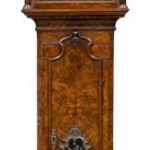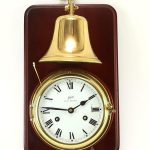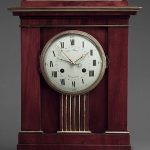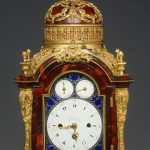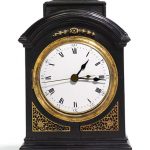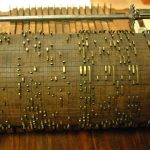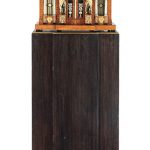Clock Bells. The most common bell in a clock is used to strike the hours, quarter hours and half hours. However, groups of small bells can also be used in musical clocks and automatons. Below are some examples of clocks which have at least one bell in their mechanism.
Bell inside of a striking clock
Dutch Rococo Brass-Mounted Walnut Longcase Automaton Clock by Antoni Van Oostrom With engraved brass arched dial, silvered chapter ring with Roman and Arabic numerals and signed Antoni Van Oostrom / Amsterdam, apertures for day, date, month and moonphase, pierced foliate hands and subsidiary seconds, the arch with polychrome-painted automaton of seven ships on a choppy sea with connection to the movement with anchor escapement and ten bells, burr walnut veneered case with shaped top, surmounted by a gilt finial, the molded cornice with carved ornaments over pierced front and side frets, break arch door with brass capped columns, canted trunk, long shaped door with Father Time lenticle, raised on a molded base. Height 8 feet 9 inches (266.7 cm).
Sold for $6,875 (includes buyer’s premium) at Doyle in 2019
Schatz Royal Mariner ship’s bell clock, 8 day, time and ship’s bell strike, spring driven movement, in a brass case with painted metal dial and external brass bell mounted on a wood plaque. 14.5″h x 8.5″w
Sold for $200 at Alderfer Auction in 2019
Clock ca. 1780–90 Workshop of David Roentgen German Its severe architectural form and restrained detailing make the case of this clock as imposing as a classical building or monument. Very much in the Roentgen style is the use of finely grained mahogany veneer, applied in a single sheet from the frieze at top down to the base, combined with brass inlay and gilt-bronze mounts
The stable base, large enamel dial with bold roman numerals, and steel hand that indicates the day of the month make it the ideal timepiece for a desktop.
In keeping with the quiet elegance of the case, the movement signed by Élie Preudhomme, marks the half hours with one bell tone. The dial is signed “Jean Thomas / Petersbourg.” Thomas was a Swiss clockmaker who lived in St. Petersburg in the early nineteenth century, repairing and trading clocks. Only a few clocks made by him are known.
Reference: The Metropolitan Museum of Art
Bracket Clock Made by: Markwick-Markham partnership (about 1725–about 1805) English (London) about 1760–80
The rectangular tortoise-shell veneered clock case is canted at the corners and arches above the dial to support a dome surmounted by a tall baluster-shaped gilt-bronze finial. The case is supported on four double-scroll gilt-bronze feet. Other gilt-bronze mounts include a guilloche band located above the feet, the four corner supports which include scrolls, acanthus leaves, and berries, openwork panels at the side composed of scrolls, flowers, and a vase of flowers, four vase-shaped finials above the projecting canted corners, openwork decorated with C-scrolls and vase of flowers that covers the spandrels, an openwork leafy scroll collar at the base of the dome, and oval bands headed by bows above. The plate that surrounds the principal dial is silvered and decorated with champleve polychrome enamels. “Chime” and “Not Chime” on one upper dial; a second dial indicates the four tunes that can be played on the nest of bells.
Reference: Museum of Fine Arts Boston
A SMALL ROSEWOOD QUARTER STRIKING AND MUSICAL TABLE CLOCK, CHINESE, CIRCA 1800 3¼-inch enamel dial with centre seconds, the three train fusee and chain movement with verge escapement, the plain three-arm steel balance mounted on the backplate, quarter striking and playing one of two tunes on a nest of five bells with thirteen hammers at the hour, the backplate engraved in the neo-classical manner with a vase of flower and floral scrolls, the case with broken-arch top and concave-sided cresting above pierced gilt-brass foliate frets, moulded base and gilt-brass splay feet 25.5cm. 10in. high
Sold for 7,250 GBP at Sotheby’s in 2019

